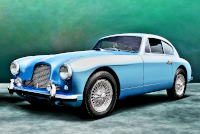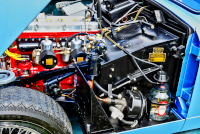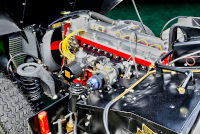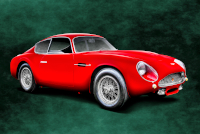Location:
Radnor Hunt Concours d'Elegance, 2013
Owner: Don & Harris Brodie | Rosemont, Pennsylvania
Prologue:
Aston Martin is not a strong focus of mine. I would love to see more of the classic era cars, the Ulsters and Speed Models. I very much like the DB3S. My interest wanes after the DB4. But I do find the DB2/4 interesting—on paper, a very good formula, a mix of old engineers, new designers, exotic influences, and bold aspirations. And I find this DB2/4 a perfect representative of everything that, by luck, went just right. I particularly love that we can see the LB6 motor in detail. For these reasons, I'm thrilled to add the DB2/4 to the our modest Aston Martin portfolio.
- - - - - - - - - -
► Image Source 1-3: Nikon D600 (24.3 MP) | Image Source 4 by E, edited by the author: Nikon D200 (10.2 MP)
References:
- Noakes, Andrew. "Aston Martin DB, 70 Years" Quarto Publishing, London, UK. 2017. (Revised edition: White Lion Publishing, 2019) page 29-42
- UltimateCarPage: As ever, a good overview of the first series DB2/4, by Wouter Melissen, (prior to December, 2004).
The DB2 is the conjunction of Aston Martin, Bentley, and Lagonda. David Brown purchased Aston Martin in February of 1947 for £20,500, some time after spotting an un-named "High Class Motor Business" advertised for sale in the Times of London. In 1948, Brown received the liquidated assets of Lagonda after Armstrong-Siddeley, Jaguar, and the Rootes Group each removed their own bids, leaving Brown's £52,500 offer on the table. (He'd assumed his offer would be rejected.) With Lagonda came designer Frank Feeley and a dual overhead cam 6-cylinder motor developed under the supervision of W.O. Bentley. Bentley had invested much of his engineering knowledge in Lagonda following the 1931 purchase of his namesake marque by Rolls-Royce, forever changing the character of Bentley cars. When Lagonda slipped into bankruptcy following the second World War, the latest W.O. Bentley motor lacked a platform for development. Under Brown's ownership, all of these components combined in a new Aston Martin car, the DB2, which Feeley designed.
A good formula—using a tubular chassis with aluminum coachwork, the Lagonda-Bentley 6-cylinder (LB6) motor, and a David Brown Engineering Ltd gearbox—the DB2 proved itself a good car. Conceived in the manner of a contemporary Touring-bodied Ferrari, the heavier Aston Martin lacked the pace of Europe's racing elite. But the firm had only begun to accumulate racing experience. Trials and tests improved the car during production, leading to its first major upgrade, the DB2/4. The DB2/4 adds rear seats for a true four-place configuration. Feeley extended the roof over the cabin and incorporated a lift-up gate, creating a hatchback before the term existed. Under the clamshell bonnet, Aston Martin installed a bored-out LB6 at just over 2.9 litres, a motor also designated for use in the forthcoming DB3, David Brown's first dedicated sports-racing car.
1955 spelled an understated year for David Brown's competitive aspirations. Three DB2/4 cars entered the Monte Carlo Rally. Though they did not win, Aston Martin acquitted themselves so well the organizers invented an ad hoc team prize in recognition. The works then entered DB2/4 cars in the Mille Miglia, a consolation after the race-bred Lagonda V-12 proved too troublesome to compete. Less favorable results followed, incorrect clutches leading to quick retirements. But, competing in the 1955 Monte Carlo Rally and the Mille Miglia landed the DB2/4 on the historical racing map. In period, the outings contributed to David Brown's growing experience as sports car manufacturer, whereas today these pursuits in two great events yield caché for a car otherwise designed as a civilized GT.
Motor: 2,922 cc straight 6-cylinder (LB6), cast iron block and hemi-head | 83 mm x 90 mm | 8.6:1 compression
Under the direction of W.O. Bentley, Willy Watson designed the Lagonda-Bentley 6-cylinder as a 2.3 litre unit, which soon expanded to 2,580 cc prior to Lagonda's liquidation. This 2.6 litre LB6 entered service in the DB2. In 1953, the refined DB2/4 received a bored-out 2.9 litre version. Most interesting about the LB6 is its barrel-type crankcase. The block is not split, but enclosed so that the crankshaft fits through from the end. The factory then fitted aluminum bearings after putting the crankshaft in place. This design creates a deeper block, which, combined with its solid casting, improves strength and rigidity.
Valvetrain: DOHC, 2 valves per cylinder
Aspiration: twin SU HV6 carburetors
Power: 140 bhp @ 5,000 rpm
Drivetrain: David Brown 4-speed gearbox, rear-wheel drive
Prior to sports cars, David Brown Engineering Ltd produced gears and gearboxes. Unsurprisingly, Aston Martin transmissions garnered a good reputation for durability.
Front Suspension: coil springs and Armstrong shock absorbers with trailing parallel links
Rear Suspension: live axle, coil springs and Armstrong shock absorbers with radius arms
Architecture: tubular chassis with aluminum coachwork
Kerb Weight: 1,257 kg (2,771 lbs)
Wheelbase: 2,515 mm (99 inches)
0-60: about 10.5 seconds
Top Speed: 168 km/h (104.4 mph)
Etymology:
The 'DB' designation appeared in the post-War revival of Aston Martin under its new owner, David Brown. The original 2 Litre Sports occupies the DB1 spot, though it was never so named. The DB2 completely updated the concept—chassis, drivetrain, and coachwork—though still appeared somewhat rudimentary in its formative years. The DB2/4 refined David Brown's new car, the '/4' designation indicating the addition of rear seats. The first series DB2/4 would become known retroactively as a Mark I upon the introduction of the second series, or Mark II, in 1955.
Figures:
Aston Martin produced 492 first series DB2/4 cars at Victoria Road, Feltham.
Englishman's GT: Italian Styling Influences on the First Aston Martin GT
Frank Feeley placed his eyes on early post-War Touring Superleggera designs, borrowing the Italian silhouette and a few choice attributes for the nose and flanks. The faired-in soffits between the grille and the fender pods use a similar approach as Carlo Felice Bianchi Anderloni's design for the Ferrari 166. The approach smooths the aerodynamic attack, with a slight rake to the grille, but remains flat beneath the headlamps. This blunt approach does not differ from early Ferrari cars—whether from Touring or Vignale, for that matter—but does lack the curvature and finesse of the Italians. From the front wheel arch, a discreet panel crease imitates Touring's style, seen on designs from the Alfa Romeo 6C 2500 to the Ferrari 166 and 212 series. But these attributes define what the David Brown Aston Martin wants to be, an English GT car, and a good car at that. The tubular chassis and aluminum coachwork follow the Italian method, while the Lagonda-Bentley motor will go on to power formidable sports-racers once the DB3S finally takes shape a few years later.
Forward Backward: Early Aston Martin Themes that Became Mainstream
In the early 1950s, Feeley conceived this configuration of a clamshell bonnet and lift-gate tail, precursor to the hatchback, which as it happens became key components of the Jaguar E-Type in 1960. Of course the E-Type is more sophisticated with its monocoq chassis derived from Le Mans success, but how interesting that the DB2/4 hit upon such a good formula so early. In contrast, by the time the 60s roll around, Aston Martin will fail to compete effectively against the E-Type, the firm's DB4 retaining conventional tubular spaceframe construction while sourcing coachwork from Touring and Zagato, achieving its ambition to be so sophisticated in lieu of modernization. The Aston Martin GT will finally wear clothes tailored in Milan, not simply "in the style of." But the cost, and the timing, will prove unfortunate. And so, though an amalgamation of English technology and an homage to Italian design, the DB2/4 is in this sense a true-to-its-roots David Brown Aston Martin.
Palladian Grille: Advent of the Signature Aston Martin Shape
Refined during DB2 development, the squared arch grille now incorporates its two ancillary wings in one unit. These three components began as separate parts, hammered out and tacked on, as opposed to neatly framed within the body. The refinement carried over from the DB2, to the the first series DB2/4, to the DB2/4 Mark II. The DB2/4 Mark III will then replace the old Palladian grille with a shape that defines Aston Martin to this day.
Last Updated: Mar 26, 2025





